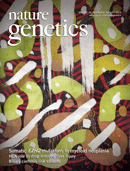
Celiac.com 08/25/2010 - The revolution in genetic studies continues to drive discoveries about the genetic triggers for celiac disease. In recent developments, a genome-wide association study (GWAS) has nearly doubled the number of single-nucleotide polymorphisms (SNPs) associated with celiac disease from 14 to 27, most of which contain genes related to immune functions.
Doctors have known for some time now that people with genetic markers DQ2 and DQ8 are more susceptible to celiac disease than those without those gene markers. This fact points to the importance of histocompatibility complex presentation of gluten antigens to immune cells.
Celiac.com Sponsor (A12):
In 2007, a landmark study established 14 celiac-associated SNPs. Recently, a team of researchers conducted a comprehensive follow-up to that study. The study team included P. C. Dubois, G. Trynka, and L. Franke. The resulting GWAS used six times more genetic samples than the 2007 study, including five European case-control data sets comprised of 4,533 celiac disease patients and 10,750 controls. In all, the team tested nearly 300,000 genes.
Based on low P values (P < 5 × 10-8) and biological likelihood of candidate SNPs being related to immune function, the team selected a total of 131 single-nucleotide polymorphisms (SNPs) for replication in an independent cohort of 4918 cases and 5684 controls. Their data identify 13 additional regions associated with celiac disease.
To determine the trigger gene for each potential locus, the team used three complementary, objective methods. They first used a computerized algorithm, known as GRAIL, that searches PubMed for specific terms related to various gene features. They next employed what is called expression quantitative trait locus mapping, which isolates variations that may influence the expression of the gene, rather than its protein structure and function. Lastly, they looked for co-expression of gene clusters in suspect candidate genes relative to known susceptibility loci. Each of these methods shed additional light on the association between suspect SNPs and celiac disease susceptibility.
However, the authors of the study go out of their way to note that, ultimately, the authors categorized loci and predicted causal genes using their "own knowledge of celiac disease pathogenesis.” This fact, they point out, emphasizes the crucial role played by knowledgable scientists exercising their insights to reap the most benefit from ‘objective’ advanced genomic data mining technologies.
This study involved genetic assessment in a very large cohort, replication in a similarly large cohort, and multiple independent approaches at refining candidate SNPs. As a result, the number of known loci of celiac disease susceptibility genes has increased from 14 to 27. Their findings also identify several new pathways of celiac disease pathogenesis that merit further investigation.
The study team also notes that these findings only account for 20% of the variance in celiac disease heritability. This, they say, points to a need for additional studies regarding genetic triggers for celiac disease.
Source:
-
Open Original Shared Link



Recommended Comments
There are no comments to display.